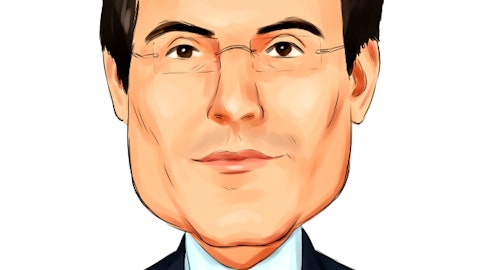Ewout Steenbergen: Yeah. Thanks Jeff. So let me explain what is benefits realignment. So benefits realignment is that we brought as of January 1, 2023, all of our employees across the world to the same benefits package, because we think it is fair that we should treat everyone the same in every country around the world. So think about the medical plans, think about the retirement plans. We have made estimates about the expenses for 2023. And for the first three quarters, the expenses came in exactly in line with our expectations, but they exceeded the expectations in the fourth quarter. And benefits costs are always not 100% certain because just to give an example, the medical costs in the US were self-insured. So they can be higher if we have higher medical claims or the matching for 401(k) contributions can be higher.
So we’re seeing this more as a onetime step-up cost and that should be in our baseline going forward from 2024 onwards. Your second part of your question about the tax rate, we saw in 2023 a bit of a benefit in the tax rate in the third quarter and the fourth quarter. And then we are seeing some upward pressure in the tax rate in 2024. So to expand on that on the third quarter of 2023, we had some favorable new guidance with respect to the utilization of foreign tax credits. And then in the fourth quarter, we had the conclusion of certain state tax audits that led to some reserve releases. So it brought the effective tax rate a little bit down in 2023 compared to a normalized level. And what we’re seeing in 2024 the implementation of Pillar 2 global minimum tax in several jurisdictions as well as the UK statutory tax rate is going up.
So 2024 is I think the right level to think about this. Where tax rate will go from a longer-term perspective is really hard to say because it really depends on government finances and where that will go around the world in the future. Thank you, Jeff.
Operator: Thank you. Our next question comes from Russell Quelch with Redburn Atlantic. You may proceed.
Russell Quelch: Yeah. Thanks for having me on the call. Sorry to go back to this but on the Ratings business and your macro forecast are implying I think is the soft landing conducive for rate cuts. And as I understand that the maturity walls built throughout the year, I appreciate some of that could be pulled forward into the front end. But I’m still struggling to square this sort of front-end loaded observation when you discuss revenues relative to your macro guidance. So maybe you could explain that again, please? And also, what you’re assuming for the non-transaction revenue growth in 2024. Sorry if I missed that. Thanks.
Martina Cheung: Thanks much Russell for the question. Just a quick one on the non-transaction. We don’t separate out our guidance between transaction and non-transaction. But as I said, we do expect robust performance in our non-transaction part of the book this year. The picture is a little counterintuitive in fact for the timing piece because you would in fact expect given our kind of predictions of three rate cuts for example by the Feds starting in the middle of the year, this year that you might see a more even result with issuance throughout the year. What we’re actually hearing from the market is a little bit different. So for bank loans and high yield for example, we’re seeing and hearing a couple of things. Number one issuers have accepted the higher for longer.
But more importantly number two there’s a good really good strong investor appetite for these asset classes. And pricing is much more constructive this year for example than it was same time last year. So these issuers are coming to market. There’s a high volume of repricing into that. So for example the bank loan January volumes for re-pricing was actually around if not a little bit higher than the full year 2023 repricing that we saw in bank loans. And then on investment grade some of that — we see that tapered a little bit this year compared to last year. The reason for that is that there were so many issuers that came to market last year but also those that are sitting waiting for rate cuts can afford to actually absorb what they’re sitting on today whether it’s using commercial paper or otherwise to wait for some of those rate cuts to play out.
Hopefully, that answers your question. As I said, it’s early. We’re in the first half of February and this is our base case. There’s a pretty wide range of possibilities here and we’ll look to get much more precise as we go throughout the year.
Mark Grant: Thank you, Russell.
Operator: Thank you. Our next question comes from Shlomo Rosenbaum with Stifel. Your line is open.
Adam Parrington: Hi. This is Adam on for Shlomo. Can you discuss the level of incentive compensation in the quarter and what is implied in 2024 versus 2023? And how much does this impact the margin guidance for 2024 as well? Thank you.
Ewout Steenbergen: Yes we brought up incentive compensation accruals in the fourth quarter. And that was driven by the strong top line performance from both the Ratings and Commodity Insights. So, for the total year 2023, our cash bonus incentive accruals are now ending up at a level above 100%. What we always do, when we do planning is to reset cash bonus incentives back to 100% from a planning perspective for the next year. So, for 2024, in the plan is embedded a 100% payout of our cash bonuses.
Mark Grant: Thank you, Adam.
Operator: Thank you. Our next question comes from Heather Balsky with Bank of America. Your line is open.
Unidentified Analyst: Hi. This is [indiscernible] on for Heather Balsky. You talked about elevated cancellations in Market Intelligence. Could you give us some details on what type and maybe size of customers you’re seeing cancel? And what kind of discussions you’ve had so far this year?
Adam Kansler: Hi Heather, it’s Adam. Thank you for the question. So through the fourth quarter in particular, the places where we saw cancellations were actually in our smallest customers, right, customers under relatively low threshold. Our larger customers while under pressure due to a range of macro reasons, those are places where we have opportunity in a vendor consolidation initiative, where those customers are looking to consolidate the number of vendors they work with given the scale and scope of relationship that they have with S&P Global that often presents opportunity for us. And accordingly, we saw much stronger renewal rates in that group of customers than we did amongst our smallest customers. I think the other places where we see pressure is discretionary spend, where customers have a decision, whether to undertake a consulting project or a new initiative.
Those are places where customers have been a little bit more hesitant into the fourth quarter. And we’re hopeful that will continue to stabilize as we get into 2024.
Mark Grant: Thank you.
Operator: We will now take our final question from Owen Lau with Oppenheimer. You may proceed.
Owen Lau: Hey, good morning. Thank you for squeezing me in. I just want to go back to AI. And I think AI it’s great and there are lots of potential, but it looks like whether clients will actually pay extra for it, it’s still uncertain. I’m just wondering, what makes you confident that you can develop a killer app that people will use it and pay for it. Thanks.
Doug Peterson: Thank you, Owen. Well, we take a view that AI is going to be embedded in everything we do. And we don’t think there’s going to be a killer app. It would be great if there were. That’s not our plan. Our plan is to look at AI to see how it can improve our productivity, how we can use it with our developers, our data management, data linking, et cetera, up into how we’re going to improve our products and build products and link them over time. As you heard from Adam, we’ve got a few very exciting products that are already being tested in the market. We’ve launched one recently and then we’ve got some more coming. We also have the capabilities of Kensho which are available on the Marketplace. So we don’t think of it as a killer app.
We think of it as continuous improvement. And we think that if you look at it over time, it’s going to be something that’s going to change the way we work and the way that our people work. So, we’re really excited about it. We’re also excited that we have such a strong internal team that we’re one of the first companies who was able to name a Chief Artificial Intelligence Officer, somebody who has the experience of Kensho of being the CEO there with the expertise. We have an open model in terms of the ecosystem we’re going to be working with. So we’re not looking for a killer application, but we’re looking to see every single way we can use it and how it’s going to improve the way we serve our customers as well to manage the business. So thank you Owen.
Let me make a couple of closing remarks. And first of all, I want to thank all of you as usual for being on the call and for your excellent questions. And it was great to have Adam and Martina on the call today. And I’m really excited about everything that we’re able to deliver in 2023. We delivered what we think is the promise of the merger. As you know we’ve paid back over $17.5 billion of capital over the last two years since the merger. We’ve been delivering innovation. We delivered on our synergies. So we’re excited about taking that energy and all of the incredible work that our people have done, and turning that now into growth into the future. I also want to thank our people as always for their incredible work. It’s what made 2023 what it is and it’s what makes me very confident about the foundation we have for going forward, and especially our leadership team who is focused on growth innovation and execution.
This is our last earnings call with Ewout. He’s been with us for seven years of remarkable service and I want to thank him. He’s helped shape our financial strategy. I know that everybody is very pleased with our margin, and as well as our capital return and that’s something that Ewout’s been instrumental in. He’s helped us lead with our accelerated growth with our innovation and he’s had a tremendous impact. He partnered with us on all of the major strategic transactions. He’s been the sponsor of Kensho for the last five years, which we now talked about many times on this call the importance that brings to the company as well as one of the initial architects as well as executors of the IHS Markit merger. So he’s done a fantastic job building a world-class finance organization.





